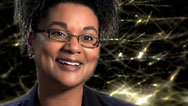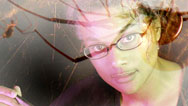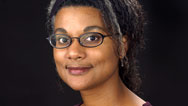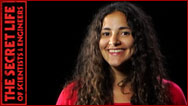
Profile: Maydianne Andrade
By peering into the sex lives of spiders, this evolutionary biologist has shown the upside of cannibalism. Airing July 7, 2009 at 9 pm on PBS Aired July 7, 2009 on PBS
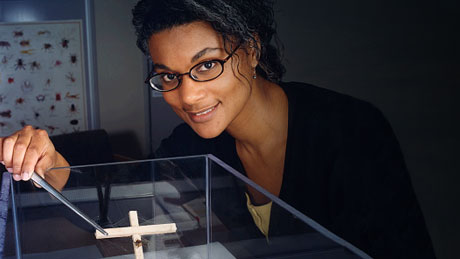
Program Description
Transcript
Profile: Maydianne Andrade
PBS Airdate: July 7, 2009
NEIL DeGRASSE TYSON: Nature is full of strange behavior and displays, much of it done in the name of love.
Take the peacock, for example. Look at this thing. How could you walk with all that weighing you down? And it's just to attract a lady friend.
And how about the angler fish? The little male latches onto the female and doesn't let go—ever.
In this episode's profile, we meet a biologist whose subjects engage in some of the weirdest, even gruesome, behavior. She insists it's worthwhile because it passes their genes on to a new generation.
MAYDIANNE ANDRADE: I do really like horror movies, really entertaining to watch horror movies that make spiders into villains. They capture something essential about what it is about spiders that scares so many people: the intelligent, stalking nature of the way that they go after their prey, maybe how fast they can move. Spiders stalk their prey like cats, you know? They're quiet, you would turn around and then suddenly one of them is there.
NEIL DeGRASSE TYSON: Meet Maydianne Andrade, evolutionary biologist at the University of Toronto. Although she loves a good scary movie, Maydianne isn't really afraid of spiders.
In fact, she's the leading expert on the Australian redback, a poisonous spider and close relative to the black widow, with one of the strangest mating behaviors in nature: the tiny male will climb onto the much larger female, and actually offer himself up as a meal.
MAYDIANNE ANDRADE: He will insert in the female, and then he'll flip and basically do a somersault to a position where his body is immediately above her fangs.
NEIL DeGRASSE TYSON: As they mate, the female will begin eating the male, alive.
MAYDIANNE ANDRADE: She'll actually pierce him and begin to chew up parts of his abdomen and eat him while he's mating with her.
NEIL DeGRASSE TYSON: Studying the mating habits of potentially deadly spiders is not for the faint of heart, but there was a time, growing up in British Columbia, when Maydianne herself was a little squeamish.
MAYDIANNE ANDRADE: I remember, in particular, one day when my brothers and I were watching TV, and this little spider sort of crawled across the floor. And we all just lost it. And we put a bowl over top of it, and we decided that I was going to quickly lift up the bowl, and my brothers had the vacuum. And of course, for a joke, the brother who was supposed to turn it on didn't. So, there I was with the bowl up, and the spider's starting to freak out, and it was one of the traumatic moments of my childhood. Things have kind of changed since then.
NEIL DeGRASSE TYSON: So how was a girl who was once terrified of simple house spiders inspired to go on to study these eight-legged creatures?
As a graduate student, she became intrigued by a strange phenomenon found in the insect world, sexual cannibalism.
DARRYL GWYNNE: The classic systems in which everybody from school kids to naturalists often find out about sexual cannibalism are praying mantids and the black widow spider.
NEIL DeGRASSE TYSON: In the case of the praying mantis, the females often eat the males during the mating act.
As her research subject, Maydianne selected the Australian redback, a spider whose females were rumored to possess a big appetite for their mates.
MAYDIANNE ANDRADE: I got some of the spiders in the lab and waited and waited, and nothing ever happened. And then finally I realized, well, you know what, they're nocturnal; they're active at night. So I have to start coming in at night. And again, I waited and waited, and not much happened.
And so one day, I just said, "You know what? I'm staying all night. It's got to be happening somehow." And so finally, at about 2:00 or 3:00 in the morning, after a five to eight hour courtship, I finally saw it. I finally saw this behavior I'd read about and wanted to base my research on.
NEIL DeGRASSE TYSON: What she saw was the male spider literally throwing himself into the jaws of the female as they mated.
MAYDIANNE ANDRADE: I mean, it was amazing. It was, like, a eureka moment, and I went running all over the building. And, of course, no one was there, because it was the middle of the night. And, I finally, I think, found a custodian and, and, you know, told him about it. And you know, he thought it was pretty strange. But still, it was a fantastic moment.
NEIL DeGRASSE TYSON: Now Maydianne's true test would begin. She left her home in Toronto for Australia, where night after night she searched for poisonous spiders.
MAYDIANNE ANDRADE: It was a very solitary, slightly creepy kind of a thing. Sometimes I would harken back to those horror movies, because I would be mesmerized in what I was watching on those webs, and then I'd suddenly realize, "I'm in this area all by myself. It's 2:00 in the morning. It's pitch black. Is that a noise I heard over in the bush?"
NEIL DeGRASSE TYSON: And at all times she had to remember that these spiders were potentially deadly.
MAYDIANNE ANDRADE: The venom goes into your bloodstream and your lymph system, and it causes pain, sweating, muscle contractions, vomiting, diarrhea, fever, chills.
NEIL DeGRASSE TYSON: But the risk would be worth it, if she could answer this evolutionary riddle: why would the male spiders sacrifice themselves? There had to be some benefit for the species.
MAYDIANNE ANDRADE: My fieldwork was aimed at asking about male opportunities for mating in nature. Was it true that males often only got one chance at mating or only encountered one female in their lifetime?
NEIL DeGRASSE TYSON: She meticulously tracked and documented the lives of nearly 2,000 male spiders.
And in the end, the results were astonishing.
MAYDIANNE ANDRADE: Unfortunately for male redbacks, they're fairly small, and once they're off their web, they're actually really vulnerable to all sorts of other animals. So most males are killed, one way or the other, before they reach a female.
NEIL DeGRASSE TYSON: In fact, Maydianne showed that only one in five male redbacks ever got to mate at all. And when they did, their ultimate sacrifice paid off. The male spiders who somersaulted into the jaws of the female during the mating act produced more offspring.
MAYDIANNE ANDRADE: For redbacks, if a female eats the male, she actually lets him mate for longer, and that means he transfers more sperm, and he'll have more babies.
NEIL DeGRASSE TYSON: This explains how the redback spider's bizarre mating behavior evolved.
MAYDIANNE ANDRADE: A male who throws himself into the jaws of death and has a thousand more offspring than his competitors, that trait is going to go on into the next generation. So, the next generation, we're going to have a thousand more males who do the same thing. And presumably, that's what happened in the evolutionary past, in redback spiders.
NEIL DeGRASSE TYSON: She published her discovery, as solo author, in the prestigious journal Science, a rare feat for an established scientist, much less a master's student.
MAYDIANNE ANDRADE: I mean, I almost cried, I was just so floored by the fact that other people thought it was important, too. It was fantastic.
NEIL DeGRASSE TYSON: Maydianne went on to get her Ph.D., and today continues her research on the Australian redback. And she now has a mate of her own, fellow professor and arachnid expert, Andrew Mason.
ANDREW MASON (Maydianne Andrade's Husband): I first met Maydianne at the lab where I was working, doing my Ph.D. I looked up from my work and sort of briefly explained what I was doing, and she asked a question about it, and that was it.
MAYDIANNE ANDRADE: He looked up, and I mean, I could almost say that that was it, from the moment we saw each other. I never used to believe in that stuff, but I do now.
NEIL DeGRASSE TYSON: They even spent their honeymoon hunting for bugs in the Canadian Rockies.
MAYDIANNE ANDRADE: It's worked out better than I could have imagined. Certainly better than my parents would have imagined, when I told them I wanted to study spiders, probably. I'm guessing they were expecting an old maid.
NEIL DeGRASSE TYSON: And together Maydianne and her husband are continuing their work on sexual cannibalism, with the hopes of making further discoveries about the secrets of evolution.
MAYDIANNE ANDRADE: A lot of people will come up to me and say, "Why sexual cannibalism?" Why would I study something so strange for so long? But really, in a way, it's what evolution's all about. It's sex and it's death, and it's all wrapped up into one really interesting story.
On Screen Text:Okay, guys, if it makes you feel any better...there is a species which practices male on female cannibalism, sort of. There are these parasitic isopods that live inside fish; the male eats the female, but there's a twist: he then becomes a female! Pretty crazy, huh?
Broadcast Credits
Profile: Maydianne Andrade
- Edited by
- Oliver Lief
- Produced by
- Joshua Seftel and Jason Cavanagh
- Directed by
- Joshua Seftel
NOVA scienceNOW
- Executive Producer
- Samuel Fine
- Executive Editor
- Neil deGrasse Tyson
- Senior Series Producer
- Vincent Liota
- Senior Producer
- Julia Cort
- Supervising Producers
- Stephen Sweigart
Joey David Jovanovich - Senior Editor and Colorist
- David Chmura
- Senior Researcher
- Sharon Kay
- Associate Producer
- Fran Laks
- Assistant Editor
- Tung-Jen (Sunny) Chiang
- Graphic Design
- Brian Edgerton
- Compositor & Animator
- Yunsik Noh
- Music
- Rob Morsberger
- Sound Mix
- Bill Cavanaugh, RazorMix, Inc.
- Assistant to Neil deGrasse Tyson
- Elizabeth Stachow
- NOVA scienceNOW Series Animation
- Edgeworx
- Associate Producers
- Julie Crawford
Jonathan Loewald
Richard Marnell
Laura Willcox - Camera
- Austin de Besche
Brian Dowley
Robin Hirsh
Stephen Kazmierski
Rob Lyall - Sound Recordists
- John Cameron
James Lindsey
Len Schmitz
Chris Strollo - Animation and Graphics
- Anthony Kraus
Sputnik Animation
James LaPlante
Dan Nutu - Researchers
- Ethan Herberman
Eric Olson - Archival Material
- AP Worldwide Photos
BBC Motion Gallery
CNN Image Source
Corbis
The Frederick News-Post and Randall Family, LLC
Getty Images
Josh Landis
National Science Foundation
NASA
Prelinger Internet Archives
The San Diego Union-Tribune
Schenectady Museum & Suits-Bueche Planetarium
Steven Snyder
WTC: The First 24 Hours, Producers; Etienne Sauret & David Carrara - Special Thanks
- Jason Bannan, FBI microbiologist
Carnegie Mellon University
Dave and Busters
Gemological Institute of America
Justin Goger Malo
George Gray, Gray Jewelers
Susan Hrishenko
Northern Arizona University
David Rasko
Sandia National Laboratories
University of Maryland School of Medicine - Neil deGrasse Tyson
- is director of the Hayden Planetarium in the Rose Center for Earth and Space at the American Museum of Natural History.
- NOVA Series Graphics
- yU + co.
- NOVA Theme Music
- Walter Werzowa
John Luker
Musikvergnuegen, Inc. - Additional NOVA Theme Music
- Ray Loring
Rob Morsberger - Post Production Online Editor
- Spencer Gentry
- Closed Captioning
- The Caption Center
- NOVA Administrator
- Mykim Dang
- Publicity
- Carole McFall
Eileen Campion
Victoria Louie
Karinna Sjo-Gaber
Karen Laverty - Marketing
- Steve Sears
- Researcher
- Kate Becker
- Senior Researcher
- Gaia Remerowski
- Production Coordinator
- Linda Callahan
- Paralegal
- Sarah Erlandson
- Talent Relations
- Scott Kardel, Esq.
Janice Flood - Legal Counsel
- Susan Rosen
- Production Assistant
- Ryan Murdock
- Post Production Assistant
- Darcy Forlenza
- Associate Producer, Post Production
- Patrick Carey
- Post Production Supervisor
- Regina O'Toole
- Post Production Editors
- Rebecca Nieto
Jason York - Post Production Manager
- Nathan Gunner
- Compliance Manager
- Linzy Emery
- Development Producer
- Pamela Rosenstein
- Business Manager
- Joseph P. Tracy
- Senior Producer and Project Director
- Lisa Mirowitz
- Coordinating Producer
- Laurie Cahalane
- Senior Science Editor
- Evan Hadingham
- Senior Series Producer
- Melanie Wallace
- Managing Director
- Alan Ritsko
- Senior Executive Producer
- Paula S. Apsell
- Image credit: (Maydianne Andrade) Courtesy Maydianne Andrade
This material is based upon work supported by the National Science Foundation under Grant No. 0638931. Any opinions, findings, and conclusions or recommendations expressed in this material are those of the author(s) and do not necessarily reflect the views of the National Science Foundation.
NOVA scienceNOW is a trademark of the WGBH Educational Foundation
NOVA scienceNOW is produced for WGBH/Boston by NOVA
© 2009 WGBH Educational Foundation
All rights reserved
Participants
- Maydianne Andrade
- www.utsc.utoronto.ca/~mandrade/
- Darryl Gwynne
- Maydianne's Master's Advisor labs.eeb.utoronto.ca/gwynne/
- Andrew Mason
- Maydianne's husband
Preview
Full Program | 09:44
Full program available for streaming through
Watch Online
Full program available
Soon

